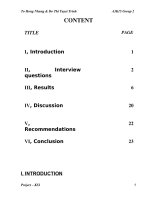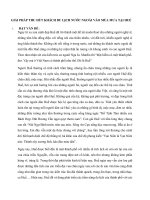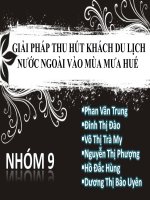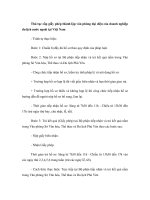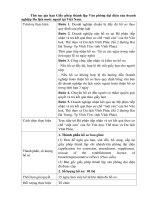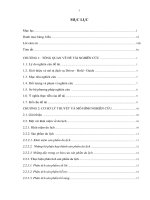Giao tiếp với khách du lịch nước ngoài và viết báo cáo từ các cuộc phỏng vấn
Bạn đang xem bản rút gọn của tài liệu. Xem và tải ngay bản đầy đủ của tài liệu tại đây (4.57 MB, 25 trang )
To Hong Nhung & Do Thi Tuyet Trinh A3K15 Group 2
CONTENT
Title
Page
I, Introduction 1
II, Interview
questions
2
III, Results 6
IV, Discussion 20
V, Recommendations 22
VI, Conclusion 23
Project – KS1
1
To Hong Nhung & Do Thi Tuyet Trinh A3K15 Group 2
I, INTRODUCTION
It is said that practice makes perfect, that’s why we have home works,
assignments, etc… when we study English object. This KS1 project is not an
exception in order to improve our all-sided English skills. In previous tasks we had
known to get information effectively then analyzing them, we also learned to work
in both small and big groups, how to share work equally among members, how to
gather individuals into an united one, etc...All of these will be very helpful for our
profession in the future, and this time is for other important skill: communicating
with foreign tourists and writing report from the interviews.
As the ones who are studying tourism, this project brings us a valuable
chance to approach one of the most important factors in tourism: tourists. This is
also our motivation to do the project.
After 2 weeks working together, we completed this interview report in
collaboration of 2 members. It contains our enthusiasm and our effort in collecting
and synthesizing information in order to get the best result. We two include:
1. Tô Hồng Nhung, who is responsible for:
+ Interview questions.
+ Results.
+ Discussion.
2. Đỗ Thị Tuyết Trinh, who is responsible for:
+ Introduction.
+ Also the results.
+ Recommendations and Conclusion.
Project – KS1
2
To Hong Nhung & Do Thi Tuyet Trinh A3K15 Group 2
II, Interview questions
1, Places:
Sword Lake (Hoan Kiem Lake) – Dinh Tien Hoang Street.
Temple of Literature – Quoc Tu Giam Street.
2, The way tourists were approached:
At the beginning, while sightseeing round and round the lake, we saw many
tourists. Taking time to check whether they were free of not, each of us took turns
to ask for the tourists’ helps.
While interviewing, we did not only focus on the answer, but also received
the extra comments of the foreigners, their feelings and some interesting
informations they shared.
After doing with the interview, we gave each tourist a little handicraft
dragonfly made by bamboo as for their helps.
3, Attitudes of interviewees and communication problems:
For the foreigner speaking English, they were very social and friendly. But
some of the foreigners refused to do the interview because there were too many
students chose the same place with us. Some showed their real interests with
interviewers, some just answered quickly to continue their plan. Some just smiled
(and we understood that’s a refuse), some totally ignored us,
For the foreigner who could speak a little English, we used some body
languages and simple words to explain what we wanted to ask, and they answered
quickly. At first they were surprised, but then they understood and sympathized
with us.
Project – KS1
3
To Hong Nhung & Do Thi Tuyet Trinh A3K15 Group 2
While taking photos with guests, we discussed about some gestures should
be used. For example, the gesture showed “Victory” in Vietnam (V) has different
meanings to some other cultures. In America, it means “Peace and Love” (we have
already learned that in Intercultural Communication). But in Europe, we have to be
very careful, because showing it in different side of the hand shows bad meaning.
Some foreigners spoke too fast and used their accent voice that we had to try
hard to understand by speaking separated words.
Sometimes, approaching the tourists might lead to misunderstanding.
Because in Vietnam, there are many beggars, street vendors, etc…approaching,
following tourists, so some interviewees quickly refused and showed their
uncomfortable expression just when they saw us (and we indeed did not a chance to
say anything).
4, Questionnaire
Name: Tô Hồng Nhung and Đỗ Thị Tuyết Trinh
Class: A3K15 Group 2
QUESTIONAIRE: “Vietnam in your eyes”
PERSONAL BACKGROUND:
• Name: …………………………………
• Nationality:………………………………
• Age: …………………………………..
• Sex: …………………………………..
• Independent or group traveler: ………………………………
QUESTIONS
1. Is this the first time you visit Vietnam?
A. Yes
B. No
2. Where do you come from?
A. Asia
B. Europe
C. America
Project – KS1
4
To Hong Nhung & Do Thi Tuyet Trinh A3K15 Group 2
D. Africa
E. Australia
3. Why did you choose Vietnam?
A. Travel
B. Visit relative, friends,…
C. Business/ Work
D. Study
E. Other
4. Where did you visit?
A. Beaches
B. Heritages
C. Nature reserve
D. Historical places
E. Other
5 Where will you intend to visit?
A. Beaches
B. Nature reserve
C. Historical places
D. Other
E. Heritages
6. Where did you get information?
A. Internet
B. Experience
C. Travel Agency
D. Reference
E. Other
7. Did you find the information useful?
A. Yes
B. No
8. Which kind of tourist service did you use?
A. Tour operator
B. Tourist Information Center
C. Group tour
9. What kind of accommodation did you choose?
A. Hotel/ Motel
B. Home-stay
C. Other
10. What do you think about the quality of accommodation?
A. Very good
B. Good
C. Normal
Project – KS1
5
To Hong Nhung & Do Thi Tuyet Trinh A3K15 Group 2
11. Have you try any kind of foods in Vietnam?
A. Yes
B. No
12. What is your feeling about food in Vietnam?
A. Very good
B. Good
C. Normal
13. Did you satisfy with the food service?
A. Yes
B. No
14. What do you think about the food sanitary in Vietnam?
A. Very good
B. Good
C. Normal
15. What mean(s) of transportation did you choose in Vietnam?
A. Bus
B. Taxi
C. Train
D. Boat
E. Bicycle
F. Other …
16. Did you go shopping in Vietnam?
A. Yes
B. No
17. Is that impressed you much?
A. Yes
B. No
18. Do you find any places of entertainment in Vietnam ?
A. Yes
B. No
19. Did you satisfy with that?
A. Yes
B. No
20. What impressed you the most in Vietnam?
A. Landscape
B. Foods
C. People
D. Other
21. Will you come back and recommend Vietnam to your friends?
A. Yes
B. I have no idea
Project – KS1
6
To Hong Nhung & Do Thi Tuyet Trinh A3K15 Group 2
III, RESULTs
1, Questionaire:
1 2 3 4 5 6 7 8 9 10 11 12 13 14 15 16 17 18 19 20 21
1.Wesl
ey
B C B A C A
B
A B A A A A A A
B
F
A A A B B A
2.Tho
-mas
A E A B E A A A A A A A B B A
E
A B A A C B
3.Iren
e
A B A A
C
D
C A A
B
C
A A A A C A
B
C
B B B B C A
4.
Axel
A B A C C
E
A A A
C
A A A B C C A
D
A A A B B A
5.Ken-
vin
B C D B D A
B
A C C A B C B B B A A A C A
6.Omar
B D B C B B A A C A B B C D
E
A A A A D A
7.
Gabrie
l
A C A F B A A B A C A B C B A
E
A B A B A B
8.Mei
Xin
B A C F A C A A A A C A C F A A A A D B
9.Jang
Youn
Su
A A D C B B C C A A B C F A A A A A B
10.Jam
es
A E A F A
C
A A A
B
A A A B C B A A A A B C B
11.Hen
ry
B C C A D B A B A A B A C A
B
C
A A A B B
12.Dan
iel
A C C D C B A A A B C B B B B B A B
13.Ker
ian
A B A F E C A B
C
A C A A C C A B B B B A B
14.Mi-
chael
B E C C E A
B
B A A A B B C D
E
A B A B C B
Project – KS1
7
To Hong Nhung & Do Thi Tuyet Trinh A3K15 Group 2
Project – KS1
8
To Hong Nhung & Do Thi Tuyet Trinh A3K15 Group 2
Project – KS1
9
To Hong Nhung & Do Thi Tuyet Trinh A3K15 Group 2
As can be seen, this doughnut chart presents the different origin of each
interviewee: Asia, Europe, America, Australia and Africa.
Among 5 continents, Europe and America have the biggest percentage of
persons, which were outlined. These two aspects both account for 28,57% of 14
interviewees.
The proportion of Australian is slightly smaller than those first top. 3 in 14
foreigners, comes in at 21,42% people came from the land of kangaroo.
28,57% originated in Asia, and African makes up only 7,15% of the data.
This chart shows the fact that the target markets of Vietnam tourism are:
Europe (especially France), America (especially USA), Australia. China, Korea,
Japan are 3 toppers of Asia marker for Vietnam. In conclusion, wherever the tourist
comes from, all the professional of tourism field should behave the same and try
best to take advantages in this competitive field.
Reasons for travel
Project – KS1
10
